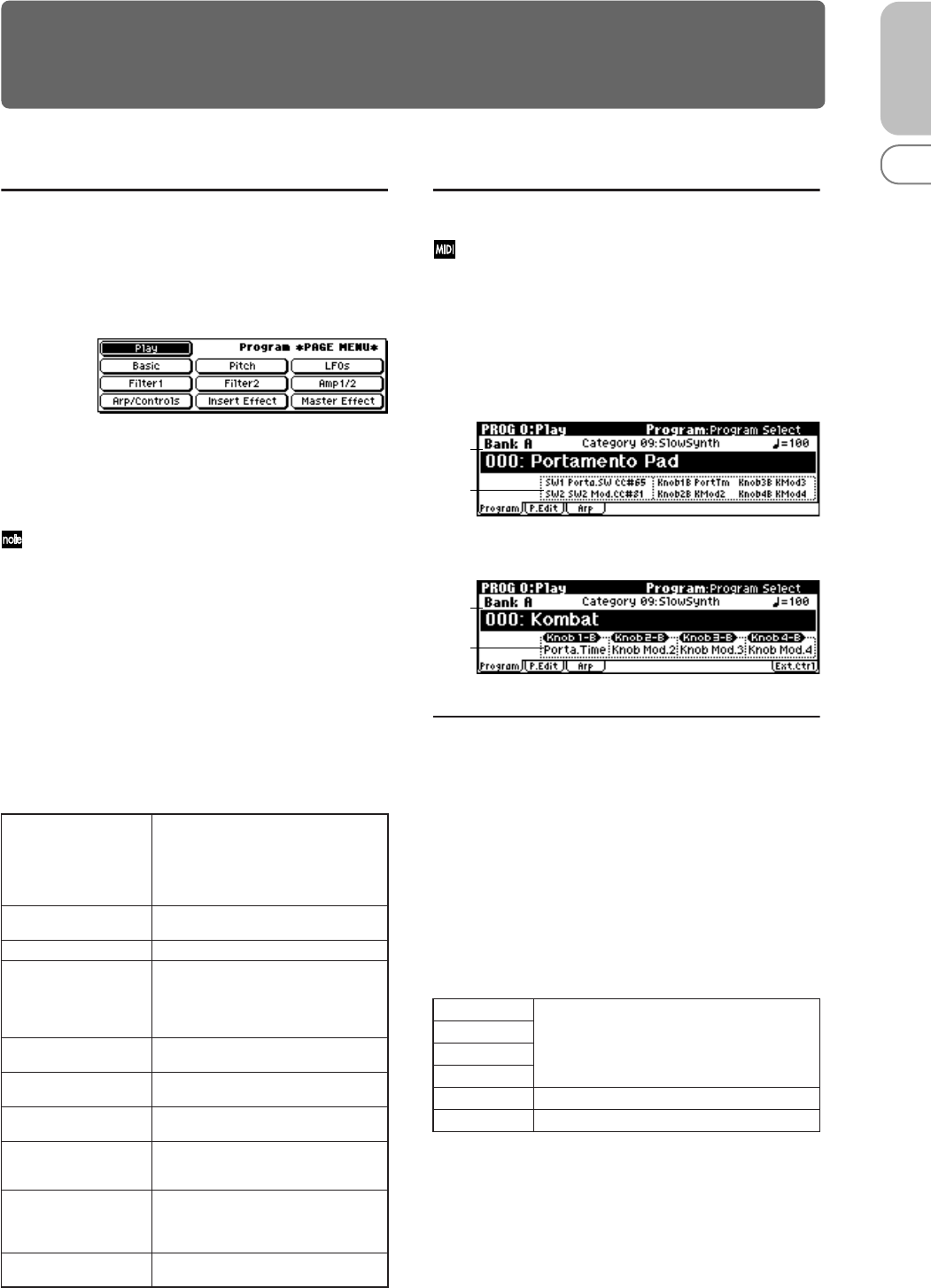
PROG
0
123456789
1
1. Program mode
PROG PAGE MENU
Use the following procedure to select the desired page from
within the current mode.
1
Press the [MENU/OK] button to access the “PAGE
MENU.”
The “PAGE MENU” will show an abbreviated name for
each page.
2
Use the ClickPoint [
√
][
®
][
π
][
†
] to select a page.
3
Press the center of the ClickPoint to access the page.
4
If the selected page is divided into multiple pages, use
the PAGE [+][–] buttons to select the page you want.
Other ways to select a page
• Use the PAGE [+][–] buttons to move between tabs of a
page.
• Hold down the [MENU/OK] button and use the PAGE
[+][–] buttons to move forward or backward in the order
of pages 0
→
1
→2→3 etc.
X50:
• Hold down the [MENU/OK] button and press one of
the numeric buttons [0]–[9] to move to the
corresponding page number. For example if you want to
move to the PROG 3: Ed–LFOs page, hold down the
[MENU/OK] button and press numeric button [3].
PROG 0: Play
In this display page you can select and play programs.
All MIDI data in PROG 0: Play is transmitted and
received on the Global MIDI Channel (☞GLOBAL 1–
1a).
0–1: Program
X50
microX
0–1a: Bank, Program Select, Category,
Cat. Hold, 10’s Hold, (Tempo)
Bank X50: [Bank A...D, G, g(d)]
microX: [Bank A...E, G, g(d)]
This is the program bank display.
X50: Use the PROG BANK [A]–[GM] buttons to select the
bank. The X50 provides rewritable banks A, B, C, and D,
each containing 128 programs (total 512). As for non-rewrit-
able program areas, it provides banks G (capital programs
for GM), and bank g(d) (drums).
X50 Bank List
Bank G will toggle between the GM and g(d) banks each
time you press the PROG BANK [GM] button.
G→g(d)→G→g(d)→G…
Play 0: Play Select and play programs.
Use the Performance Editor for easy edit-
ing, and to do simple editing of arpeggio
patterns.
microX: Select an external control set.
(☞p.1)
Basic 1: Ed–Basic Set basic program parameters such as
Oscillator and Multisample. (☞p.6)
Pitch 2: Ed–Pitch Pitch settings. Pitch EG settings. (☞p.10)
LFOs 3: Ed–LFOs Type and speed settings etc. for the two
LFOs provided for each oscillator. (Make
settings in the pitch, filter, and amp pages
to specify the depth of the LFO settings
you make here.) (☞p.14)
Filter1 4: Ed–Filter1 Filter 1 (tone) settings. Filter EG settings.
(☞p.16)
Filter2 5: Ed–Filter2 Filter 2 (tone) settings. Filter EG settings.
(☞p.21)
Amp1/2 6: Ed–Amp1/2 Amp 1 and Amp 2 (volume) settings. Amp
EG, pan (position) settings. (☞p.21)
Arp/Controls
7: Ed–Arp/Ctrls
Arpeggiator settings. (Shared with 0: Play
parameters. You may edit either.)
Controller settings. (☞p.25)
Insert Effect
8: Ed–InsertFX
Select the BUS and master effect send
level for the oscillator output.
Insert Effect routing, selection and set-
tings. (☞p.28)
Master Effect
9: Ed–MasterFX
Master Effect selection and settings. Mas-
ter EQ settings. (☞p.30)
Bank A
for preloaded programs
(for user programs)
Bank B
Bank C
Bank D
Bank G GM capital program
Bank g(d) GM drums program
0–1a
0–1b
0–1a
0–1b


















